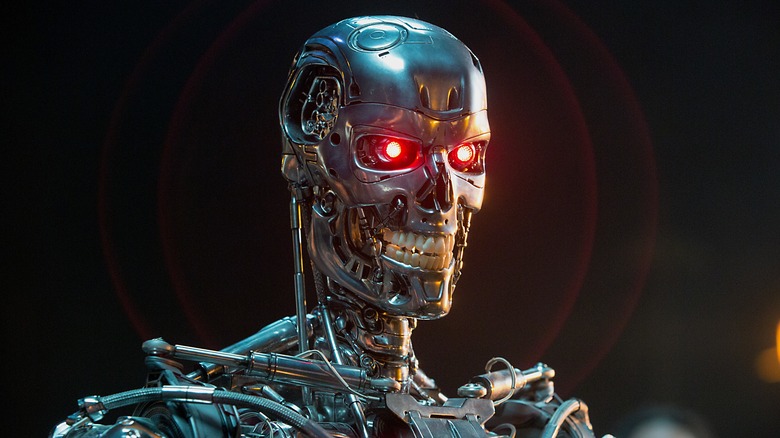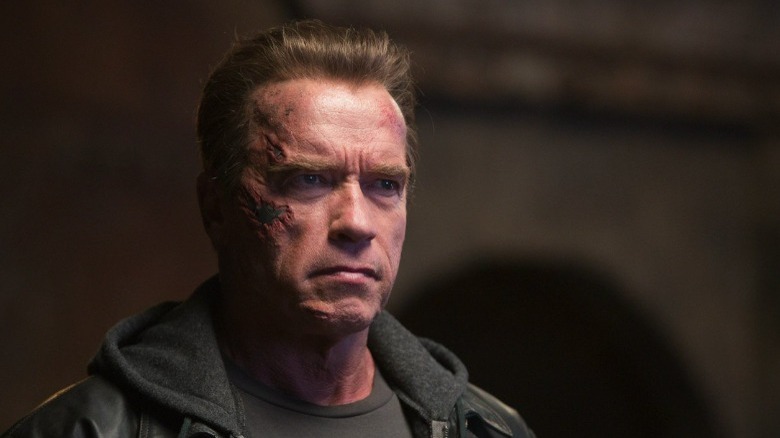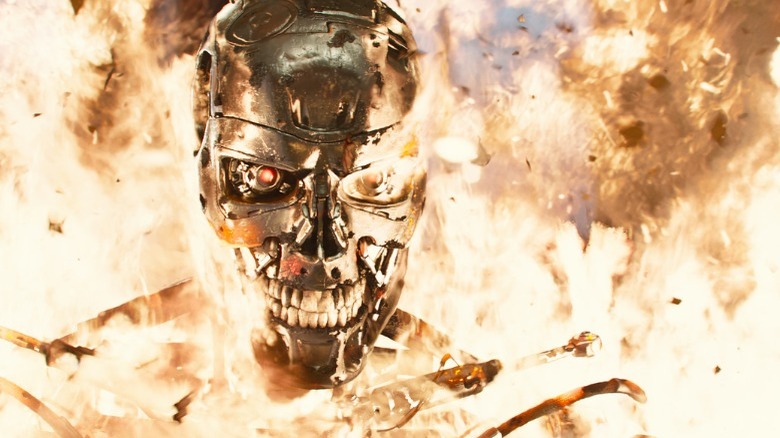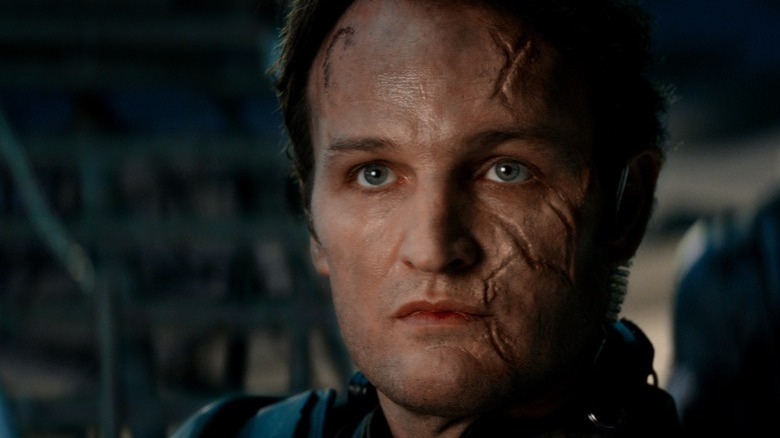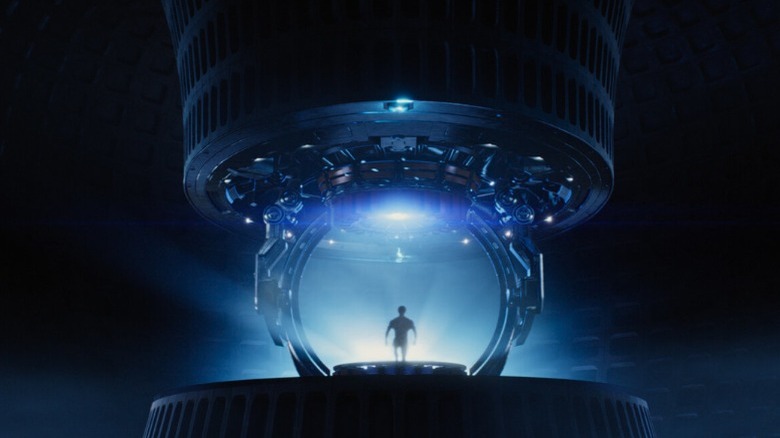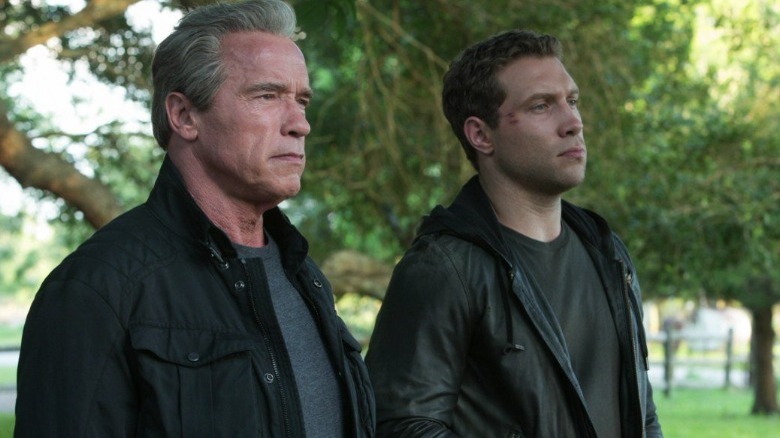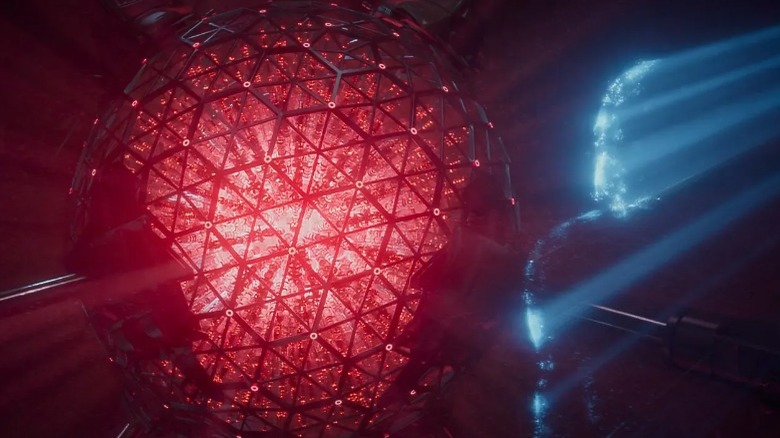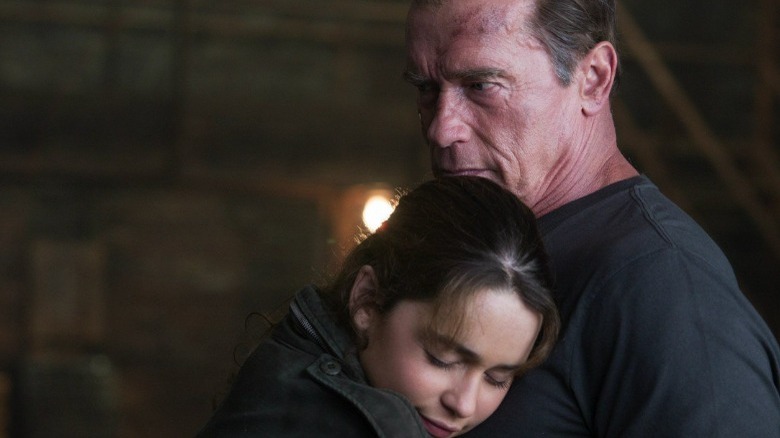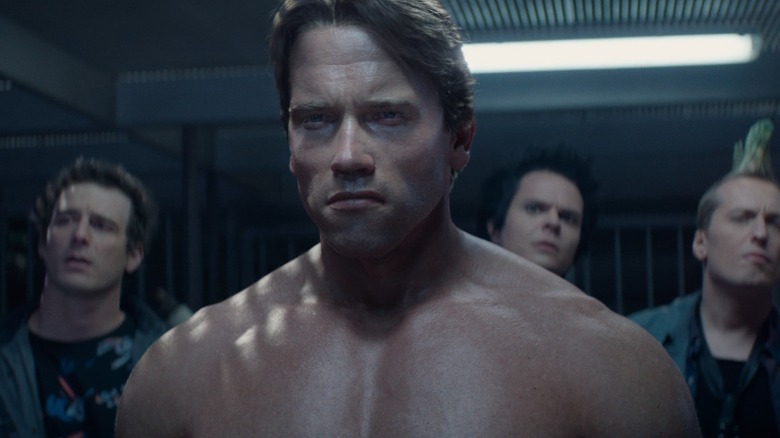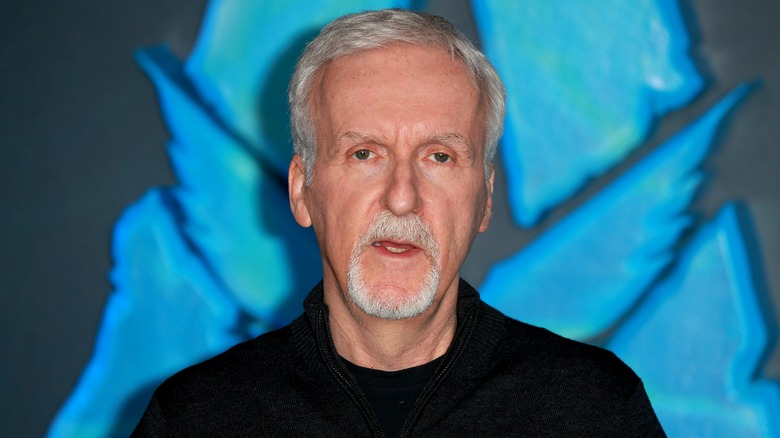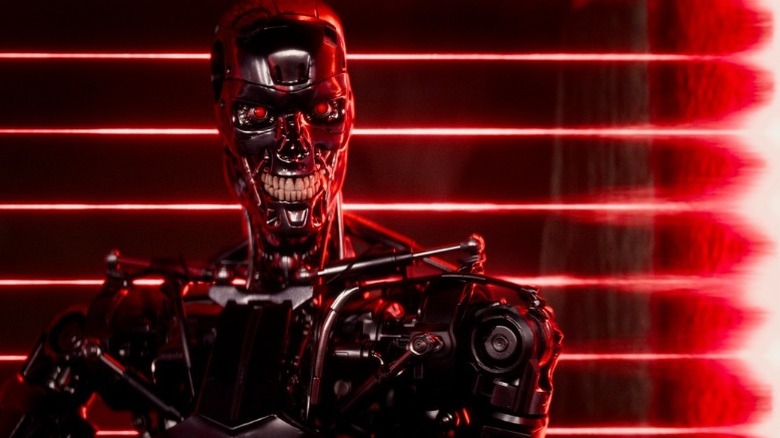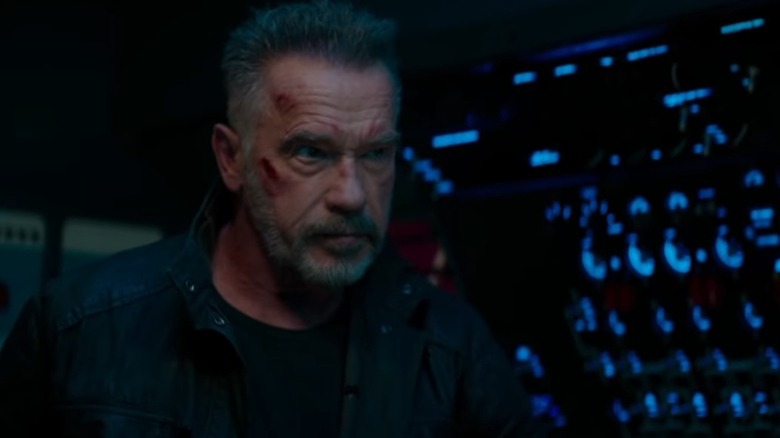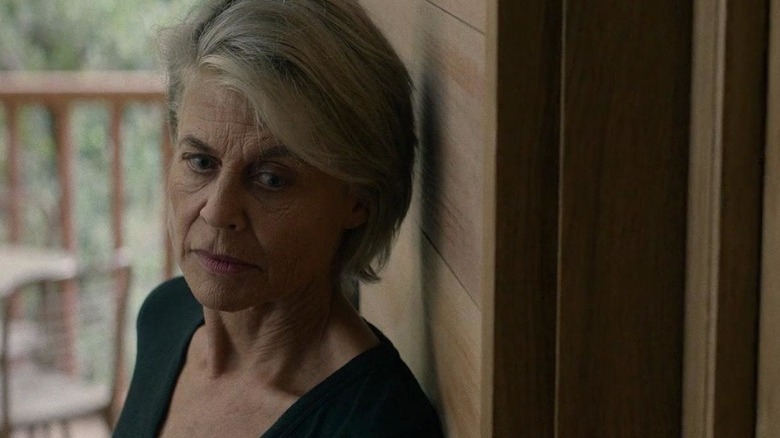The Ending Of Terminator Genisys Explained
Although it has seen mixed success in recent years, the "Terminator" franchise is still one of the most popular in the sci-fi genre. James Cameron's original movie — "The Terminator" — launched in 1984 and a sequel in the form of "Terminator 2: Judgment Day" was made seven years later. Over the years, the series has since expanded with numerous comics, television series, and additional sequels. One of the more recent releases is "Terminator Genisys," a 2015 film that sees Arnold Schwarzenegger reprise his role as the T-800 alongside Emilia Clarke and Jason Clarke.
Like its predecessors, "Terminator Genisys" features a plot with a healthy focus on time travel. A future artificial intelligence system known as Skynet works to stop the Connor family from fulfilling its destiny and destroying it in the future, while Sarah Connor and Kyle Reese have to defend themselves against robotic assassins. Considering all of that, it isn't surprising that the ending of "Terminator Genisys" can be a bit confusing, especially when the movie introduces new timelines and acts as a soft reboot of the franchise.
With so much going on in the film, let's delve into the final moments of "Terminator Genisys" and what the ending really means.
What you need to remember about the plot of Terminator Genisys
"Terminator Genisys" acts as a reboot of the "Terminator" series, ignoring most of the events of the various sequels and instead telling a new version of the story from the first movie. However, it largely follows the same basic formula in terms of its time travel plot device and the same group of characters. This includes a T-800 Terminator played by Arnold Schwarzenegger, a version of Sarah Connor portrayed by Emilia Clarke, Jason Clarke's John Connor, and Jai Courtney as Kyle Reese.
The early parts of "Terminator Genius" play out like a prologue for the original movie. John Connor and Kyle Reese are shown making a final assault on Skynet in the year 2029 with the Human Resistance on the verge of victory. In a last-ditch effort to avoid destruction, Skynet sends a Terminator to kill Sarah Connor, prompting John to also send Kyle back in time to protect his mother. John is then seemingly killed by an unknown resistance soldier as Kyle hurtles backward to 1984. The attack on John causes a paradox, though, creating an alternate timeline where Sarah Connor is a trained fighter who has been raised by another T-800 Terminator affectionately known as Pops.
After arriving in 1984, Kyle quickly finds Sarah and, with the help of Pops, hatches a plan to time travel to the year 2017 and stop Skynet just as it is about to launch its attack on humanity.
What happened at the end of Terminator Genisys?
The ending of "Terminator Genisys" begins with the revelation that the attack on John by a resistance soldier was orchestrated by Skynet. The artificial intelligence, operating in physical form, transforms John into a new type of Terminator by manipulating his body at a cellular level. Skynet then sends John back to oppose Sarah and Kyle to ensure Skynet is still created. Fortunately, Pops is able to distract John long enough to allow the trio to escape and retreat to a safe house where they can plan an attack on Genisys headquarters.
Infiltrating the Cyberdyne complex where the Genisys mainframe is housed, Sarah, Kyle, and Pops are able to plant bombs to destroy the building. While being pursued by John, the three protagonists are ultimately able to destroy Genisys before it launches, seemingly stopping Skynet from being created in the process. During the encounter, Pops battles John one last time with the fight ultimately claiming both of their lives, though Pops is quickly resurrected, thanks to the fact his body landed in nearby mimetic polyalloy.
With Skynet no longer a threat, the group heads off together and meets with a young version of Kyle living in his childhood home. Here, Kyle tells him what has happened and explains how the child version of himself will have to warn the future Kyle about the dangers of Genisys.
What does the ending of Terminator Genisys mean?
For many viewers, the most confusing part of "Terminator Genisys" is the reason behind Kyle having to find his younger self to warn him about Genisys becoming Skynet. The explanation for this comes from its origins right at the start of the movie when Kyle volunteers to be sent back in time. Witnessing John be attacked by Skynet in 2029 causes a temporal paradox and results in a brand new timeline being established. This is the reason that Kyle seems to experience new childhood memories that he was previously unaware of, as these memories come from a different version of his younger self than his original reality.
Sarah and Pops had initially planned to travel to the year 1997, as this is the time that Skynet was originally set to launch its devastating attack on humanity. However, Kyle realizes that the timeline has been altered because of the paradox and understands that the future creation of Skynet has likely been changed as well. Fortunately, the memories he experienced while traveling back in time from 2029 warned him about this alteration and he is able to persuade Sarah and Pops that they should instead aim for 2017.
At the very end of the film, Kyle has to visit his younger self and deliver the information to close the time loop and ensure it makes logical sense. Otherwise, the child version of Kyle would not be able to warn the older Kyle about the timeline changes that pushed back Skynet's creation by two decades.
The film changes how to think about the timelines in Terminator
Prior to "Terminator Genisys," it appeared as if the timeline in the series worked as a sort of closed time loop. Skynet sent Terminators back in time to attack the Connors while the Human Resistance responded in kind to protect them with its own operatives. The events of the sequels were a direct consequence of what had happened before, with Skynet and the future humans seemingly trapped in a constant battle as they each used time travel to accomplish their goals.
"Terminator Genisys" switches things up by creating an alternate timeline. Events are changed quite drastically in this new reality, with Judgment Day now taking place 20 years after it did in the original timeline, while the creation of Skynet now comes from the operating system known as Genisys. Exactly what caused this alternate reality isn't made clear, but it is obvious it has something to do with the fact that John Connor was attacked and forcibly transformed into a human-cyborg hybrid Terminator and that a different T-800 model was sent to 1973 to protect Sarah Connor.
The end result of this is that viewers can now consider each film in the "Terminator" franchise as a separate timeline set in an alternate reality rather than everything necessarily taking place in the same continuity — something that proves important for the next film in the franchise, "Terminator: Dark Fate."
Who sent Pops back in Terminator Genisys?
"The Terminator" establishes that Sarah Connor is a young college student and waitress, unaware of her importance to the future of humanity. The only reason that she is able to survive the attack of the original T-800 Terminator when it arrives in 1984 is because of the intervention of Kyle Reese. Of course, she later develops her skills so that she can train her son John to become an effective leader for humanity following Skynet's attack. But this only happens after she encounters Reese and understands the dangers posed by various Terminators.
In "Terminator Genisys," Sarah has lived a very different life. Her parents were killed when she was just nine years old by a T-1000, but she was rescued and subsequently raised by a reprogrammed T-800. This Terminator model trains Sarah so she is a capable fighter by the time that Kyle arrives in 1984. Yet it is never explicitly explained who sent this T-800 back in time to protect Sarah in the first place.
An obvious answer is that the reprogrammed Terminator was sent by John, Kyle, or some other member of the Human Resistance in the future to safeguard against Skynet's assassination attempts. Some fans, though, have speculated that Skynet itself may have been responsible in an attempt to break a perpetual loop that always saw it eventually be destroyed by humanity. Without a direct sequel to "Terminator Genisys," it is impossible to really know what the true answer is.
A mid-credits scene provides more information
Mid-credits scenes have become commonplace in modern action movies, and "Terminator Genisys" was no different in that regard. The ending of the film sees Genisys seemingly destroyed in the explosion set off by Sarah, Kyle, and Pops. But the mid-credits scene sheds new light on events at the conclusion of the story. Despite only being a few seconds long, the brief video offers an important revelation about Genisys. With the camera panning on the destroyed complex, it is revealed that Genisys has in fact survived.
Not only does this open up the possibility of further sequels exploring Genisys as the origin of Skynet but it also confirms something fans had long suspected: Judgment Day is inevitable and cannot be fully stopped. No matter what Sarah, John, Kyle, or anyone else does, the rise of the machines is predestined and will always happen. In some form, Skynet will arise, even if it requires a new origin, as is the case with the operating system Genisys. At best, the process can be delayed and stalled but at some point, Skynet will still start a war with humans.
Explores what it means to be human
The earliest Terminators in the franchise are portrayed as little more than merciless killers without human emotion. By the time of the sequel in 1991, a T-800 model sent back by the resistance to protect John Connor demonstrates that it is possible for machines to be friendly towards humans. It obeys commands by John and slowly learns to behave in a more human-like way, thanks to instruction by Sarah. Yet even this Terminator doesn't really display emotion or have proper human qualities.
That all changes with "Terminator Genisys." The T-800 model sent back to 1973 to protect Sarah is affectionately known as Pops and shows more emotion and human-like behavior than any previous machine seen in the franchise. It is protective of Sarah, raising her from the age of nine and acting as a father to her. The pair form a close bond in this time and undoubtedly care strongly about each other. Pops even keeps drawings made by Sarah when separated from her and Kyle for several decades and refers to her as "his Sarah."
This is a level of emotion that makes viewers question whether these machines have the capability of being considered real people. After all, Sarah views Pops as part of her family, and to any outsiders, Pops would appear to be a close relative who deeply loves her. Even Genisys takes on human qualities, creating a physical version of itself.
Arnold Schwarzenegger had problems with the story
Arnold Schwarzenegger is the one constant in the "Terminator" franchise throughout its history. He has appeared in every film, with the exception of "Terminator Salvation," playing both good and evil versions of the T-800 model that was made famous from "The Terminator." But it now seems as if Schwarzenegger has finished with the franchise and no longer wants to be part of any future movies that may be produced.
Speaking to The Hollywood Reporter, Schwarzenegger explained his reasoning. "The franchise is not done," he told the interviewer. "I'm done. I got the message loud and clear that the world wants to move on with a different theme when it comes to 'The Terminator.' Someone has to come up with a great idea."
Part of the reason for this is that he felt the script for "Terminator Genisys" was just not very good. The actor went on to talk about how the cast and crew were aware that the final two movies in the series so far were not on par with the quality of the first films. He said: "Then five and six didn't close the deal as far as I'm concerned. We knew that ahead of time because they were just not well written."
James Cameron gave it his seal of approval
While some people may have questioned the quality of "Terminator Genisys," the franchise's creator wasn't among them. James Cameron co-wrote and directed the first two entries in the series and returned for "Terminator: Date Fate" to help with the story. But he wasn't involved in any of the other installments. Despite claiming several times in the past that the "Terminator" franchise should have ended after the release of "Terminator 2: Judgment Day," the director changed his mind when "Terminator Genisys" hit cinema screens.
After being able to watch an early screening of the film, Cameron revealed how much he had enjoyed it. In fact, he went so far as to consider it the third movie in the series and a true sequel to "Terminator 2: Judgment Day." Speaking to Yahoo, Cameron said: "I feel like the franchise has been reinvigorated, like this is a renaissance. The new film, which I think of as the third film, you see [Arnold Schwarzenegger] take the character even further."
Cameron was also impressed by the main story twist of John Connor becoming the villain pursuing the heroes rather than the savior, as he is normally portrayed. "The idea of taking John Connor and flipping him to the bad guy, it's kinda cool, because you got to riff against expectations," said Cameron. "It's all about the twists."
What the end of Terminator Genisys means for the franchise
"Terminator Genisys" was intended to be a reboot of the series that would be followed by several sequels, expanding the story beyond what had been told in the original franchise. There were actually two planned sequels as well as a television show, but all of these were canceled following the poor box-office performance of the film. This effectively put a halt on all "Terminator" projects and eventually led to the proposed trilogy being shelved in favor of "Terminator: Dark Fate." Not everyone was sad about the news, though: Emilia Clarke said the filming process was incredibly difficult and she was relieved she wouldn't have to return to reprise her role.
According to reports, the sequels would have focused largely on John Connor, digging into what happened to him when he was captured by Skynet and transformed into a new advanced Terminator. They would likely have also delved into the mystery of who sent Pops, the T-800 protecting Sarah Connor, back in time. The mid-credits scene also provided confirmation that Matt Smith was not just playing an advanced T-5000 Terminator called Alex, but is actually a physical representation of Genisys/Skynet. This likely would have seen Smith return in the sequel, with this new version of Skynet explored further.
Terminator: Dark Fate ignores everything that happens in Genisys
After the cancellation of the "Terminator Genisys" trilogy, James Cameron returned to the franchise for the first time since "Terminator 2: Judgment Day." While he didn't write the script or direct, he acted as a producer and played a part in developing the story. Despite his previous comments about "Terminator Genisys" being a good film, those involved in "Terminator: Dark Fate" didn't want to be tied down by what had come before, and chose to ignore everything after "Terminator 2: Judgment Day."
What that means for the franchise as a whole is that "Terminator: Dark Fate" can be considered the third official movie in the franchise, and this movie is a direct continuation of "Terminator 2: Judgment Day." In an interview with The Hollywood Reporter, Cameron explained the approach, saying, "This is a continuation of the story from Terminator 1 and Terminator 2. And we're pretending the other films were a bad dream. Or an alternate timeline, which is permissible in our multi-verse."
It is entirely possible to ignore everything that happened in "Terminator Genisys," and not even consider it part of the main story of the franchise. In that sense, the ending doesn't have any real consequences for the rest of the series and what might happen in the future.
The series is likely to be rebooted, making Genius obsolete
"Terminator: Dark Fate" was for many people seen as a return to what made the original movies so special. It received a far more positive reception than its predecessors from both critics and viewers. However, the movie still failed to find any real success at the box office, and this led to potential sequels also being canceled, as was the case with "Terminator Genisys." That doesn't mean the franchise is dead, though, with James Cameron revealing in late 2022 that discussions are currently taking place about a way to continue the series.
"If I were to do another 'Terminator' film and maybe try to launch that franchise again, which is in discussion, but nothing has been decided, I would make it much more about the AI side of it than bad robots gone crazy," said the director on the "Smartless" podcast (via The Playlist). This suggests that any future "Terminator" movie would be a complete reboot of the franchise featuring new characters and a fresh cast, effectively making "Terminator Genisys" and the other entries in the original series obsolete.
